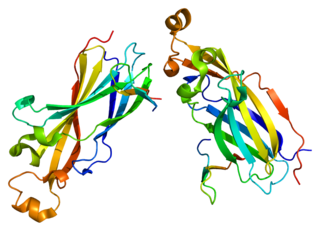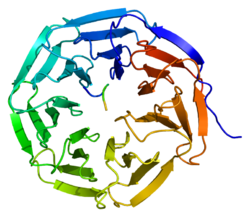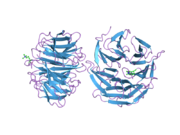
Histone-lysine N-methyltransferase 2A also known as acute lymphoblastic leukemia 1 (ALL-1), myeloid/lymphoid or mixed-lineage leukemia1 (MLL1), or zinc finger protein HRX (HRX) is an enzyme that in humans is encoded by the KMT2A gene.

Protein arginine N-methyltransferase 5 is an enzyme that in humans is encoded by the PRMT5 gene. PRMT5 symmetrically dimethylates H2AR3, H4R3, H3R2, and H3R8 in vivo, all of which are linked to a range of transcriptional regulatory events.

Histone H2B type 1-K is a protein that in humans is encoded by the HIST1H2BK gene.

Histone cluster 2, H3, pseudogene 2, also known as HIST2H3PS2, is a human gene.

Polycomb protein EED is a protein that in humans is encoded by the EED gene.

Histone H3.1 is a protein in humans that is encoded by the H3C1 gene.

Methylosome protein 50 is a protein that in humans is encoded by the WDR77 gene.

Protein HIRA is a protein that in humans is encoded by the HIRA gene. This gene is mapped to 22q11.21, centromeric to COMT.

Histone H3.1 is a protein that in humans is encoded by the HIST1H3F gene.

Histone-lysine N-methyltransferase SETD7 is an enzyme that in humans is encoded by the SETD7 gene.

Histone-lysine N-methyltransferase 2D (KMT2D), also known as MLL4 and sometimes MLL2 in humans and Mll4 in mice, is a major mammalian histone H3 lysine 4 (H3K4) mono-methyltransferase. It is part of a family of six Set1-like H3K4 methyltransferases that also contains KMT2A, KMT2B, KMT2C, KMT2F, and KMT2G.

Set1/Ash2 histone methyltransferase complex subunit ASH2 is an enzyme that in humans is encoded by the ASH2L gene.

U3 small nucleolar RNA-associated protein 18 homolog is a protein that in humans is encoded by the UTP18 gene.

Retinoblastoma-binding protein 5 is a protein that in humans is encoded by the RBBP5 gene.

Lysine-specific demethylase 6A also known as Ubiquitously transcribed tetratricopeptide repeat, X chromosome (UTX), is a protein which in humans is encoded by the KDM6A gene. It belongs to the 2-oxoglutarate (2OG)-dependent dioxygenase superfamily.

WD repeat-containing protein 6 is a protein that in humans is encoded by the WDR6 gene.

WD repeat-containing protein 3 is a protein that in humans is encoded by the WDR3 gene.

WD repeat-containing protein 26 is a protein that in humans is encoded by the WDR26 gene.
H3K4me3 is an epigenetic modification to the DNA packaging protein Histone H3 that indicates tri-methylation at the 4th lysine residue of the histone H3 protein and is often involved in the regulation of gene expression. The name denotes the addition of three methyl groups (trimethylation) to the lysine 4 on the histone H3 protein.

Histone cluster 2 H3 family member a is a protein that in humans is encoded by the HIST2H3A gene.



































